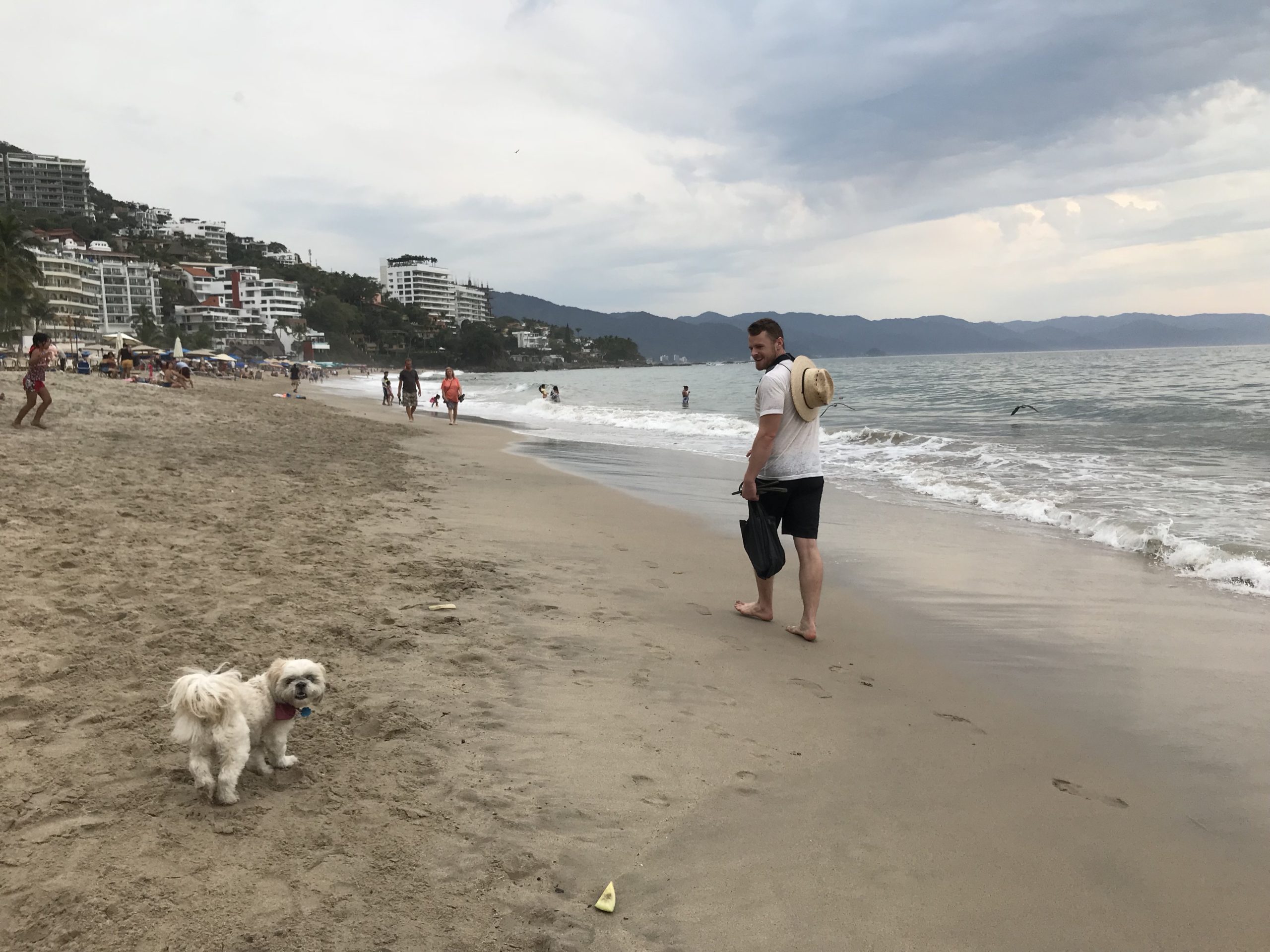As of December 16, 2019, a dog health certificate is no longer a requirement from a veterinarian to enter Mexico, according to the United States Department of Agriculture. This new rule for traveling with your pet to Mexico saves you hundreds of dollars, and pets crossing the border now visit the Mexican Animal and Plant Health Inspection Office (OISA), and check in with SENASICA. That’s great news. Pet travel to Mexico requirements are less strict that before.
I vacation in Mexico frequently with my dog Ruby (@JetSetRuby on Instagram), at least four times a year, and when she gets on the plane, she knows she’s going to get spoiled. Mexico is incredibly pet friendly. That’s right. Almost every Mexico hotel in top beach destinations like Puerto Vallarta, Playa Del Carmen and Cabo are super pet friendly (not the case in cities, and not the case in Cancun since they’re a little more strict).

While Ruby’s having all the fun, it can be stressful for me and pet owners bringing their dog to Mexico, especially when you have to go through inspection at customs, which has taken up to an hour! Before I go any further, you should read this story on the Pros and Cons of Traveling with a Pet.
For me, traveling the Mexico with my dog is obviously worth it, and the first thing you’ll want is a pet airline-approved carrier before you do anything else. Here’s a great one I use from Amazon. It’s simple and affordable, but best of all, durable! I’ve had it for about 8 years, and Ruby won’t use any other carrier.
OK, so here’s the big challenge with taking your pet to Mexico that you no longer have to worry about. In fact, pay close attention if you’re all about pet travel to Mexico, and are thinking of bringing your dog to Mexico. I get a lot of messages from people on pet and dog travel requirements to Mexico, so I thought I’d just answer all here.
In the past, you would have to get the mandatory health certificate from your vet — and it’s expensive. I have gotten Ruby a health certificate in Los Angeles, New Orleans, Atlanta and New York City, and the cost for a health certificate to go to Mexico ranged from $100 to $250! This is insane. Just for the vet to do a pet exam and print out a piece of paper, you had to shell out big bucks, which is fine, but it adds up the more you travel to Mexico, so thankfully, you no longer need to get this certificate. You save a lot of money.

But here’s another reason it’s *so great* a dog health certificate requirement is no longer needed when traveling with your pet to Mexico. As I mentioned before, when you arrive in Mexico, you have to stop at the dog inspection area at customs. The last two times I stopped in this area, the inspector would “find an issue” (like “OH your dog didn’t have the worm test”) and tell me that they would have to hold me and Ruby until a local vet arrived.
The first time that happened, while I was waiting, a woman who had just gotten off a flight with her dog stopped by to do the dog check (and breezed through). She told me to slip the inspector cash, that she had to do it last time. So, I had to pay the inspector guy $100 US cash just to let me get out of the airport (of course he did within seconds, and that local vet no longer mattered).
So, not only would I spend up to $250 for a health certificate, I would have to pay off the customs inspector pet guy. This was in Cancun, and I found out from other travelers with pets that this was common.

There was another time when, even with my health certificate, the inspector guy said that I definitely needed the local vet to come inspect her, even though she was clearly healthy. This was in Puerto Vallarta. We argued for about 30 minutes, and finally, he let me go because I said that I had to meet family in 20 minutes and I would come back with a local vet’s certificate (even though I already had an approved one from my vet in the US). He held my driver’s license as collateral.
BTW: If you buy literally anything through Rakuten, you get up to 10 percen tcashback (sort of like Honey). So definitely buy all your pet stuff with Rakuten.
I got him the form from a local vet (which was obviously unnecessary and frustrating), and I did come back when I was departing, but airport staff wouldn’t let me through to the customs area from this side of the airport, proving the inspector had never made this request to a passenger before (otherwise, he would have known we can’t go to the pet inspection area on this side). I never got my license back, and it was a total freaking mess. I think he was bummed I didn’t slip him cash, so he aimed to make things hard for me.
So, that’s the kind of stuff you often had to deal with when going through Mexico customs with your pet. I would think that, because they have a local vet that inspects your pet on site now, it won’t be so complicated if you run into issues.

For the record, the slip-the-inspector-guy cash thing didn’t happen all the time. I’ve taken Ruby to Mexico about 20 times now, and it’s only happened twice.
Luckily, this will no longer be an issue.
Mexico is easily one of Ruby’s favorite destinations, where she has been wined and dined with pet dining menus, got a pet massage in a cabana and can run freely on the sprawling beach, leash-free (depending on the beach), so I’m glad that I will also get to unwind with the new rule!

Here are the new requirements for entering Mexico with your dog or cat.
Requirements for dogs and cats originating in, and proceeding from, the United States of America to Mexico:
(Combinacion numbers 007-35-61-USA-USA and 013-08-504-USA-USA)
- Upon arrival to Mexico with the pet dog(s) and/or cat(s) in a clean cage(s)/carrier(s), travelers must visit the Mexican Animal and Plant Health Inspection Office (OISA), to contact the official personnel working with SENASICA. The official personnel will verify the following:
- That the dog(s) and/or cat(s) does/do not present signs of infectious and contagious diseases.
- The animal(s) is/are free of ectoparasites*
- The animal(s) does/do not present fresh wounds or wounds in a healing process.
*If at the physical inspection parasites are detected, the owner/user should contact a Veterinarian (anyone) in order he/she applies an appropriate treatment. If ticks are detected, the SENASICA personnel will take a sample of the ectoparasite(s) for its diagnostic at the official laboratory, and will verify that all parasites are removed from the pet(s). The animal(s) will remain at the OISA [Mexican official office] until confirmation that the parasites are not exotic/foreign to Mexico, or are not under an Animal Health Program (Campaign) in Mexico. Otherwise, SENASICA, through the Animal Health General Direction, will determine the measures to be applied. Expenses derived from such actions, should be paid by the importer.

Other pet travel to Mexico dog requirements / information about inspection at the OISA, upon presentation of the shipment in Mexico:
B. If your pet(s) is/are under treatment due to lesions and/or infections on the skin due to mites, dermatomycosis, dermatophylosis, hairless or similar lesions, you should present to the official personnel of SADER/SENASICA the diagnostic and treatment instructed by the Veterinarian. Such information should be presented in a letterhead, including the professional registration number (or equivalent). Enclosed to the letterhead, it can be accepted a copy of the professional registration number (or equivalent).
C. Compliance of what is indicated in this document, does not exempt the importer of presenting documents, complying with applications and/or procedures requested by other authorities.
D. When the cage/carrier is dirty and/or contains bed disposable (newspaper wood – other materials) toys or edible products, a disinfection will be applied, removing all that is inside of the carrier/cage, for a proper destruction.
E. Only the portion of food used to feed the animal during the day of arrival, will be allowed.
This HRZ only applies to domestic dogs (Canis lupus familiaris), and domestic cats (felis catus).
Now that you know the pet and dog travel to Mexico requirements, click this link or banner below to get the best airfare and hotels.
Best pet-friendly hotels and flight deals on Tripadvisor
More Travelbinger stories:
The pros and cons of traveling with your pet
5 best pet-friendly destinations in North America
6 expert tips for flying with your pet
Travelbinger is proud to be a publisher with Google News and Apple News.
Some of the links in this post are affiliate links. If you click on the link and purchase the item, I will receive an affiliate commission. Please do! I’m a one-man team for this website, so any help is sincerely appreciated.
Travelbinger is now on YouTube! Subscribe here for exclusive travel tips and advice from founder Jimmy Im. Follow us on Twitter, Facebook and Instagram.
Jimmy Im has traveled to 113 countries, stayed in over 600 hotels and has flown a million airmiles. He lives in New York City.

Does the same rule apply upon returning to the US?